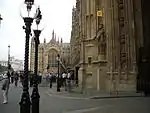Victoria Tower
The Victoria Tower is a square tower at the south-west end of the Palace of Westminster in London,[1] adjacent to Black Rod's Garden on the west and Old Palace Yard on the east. At 98.5 metres (323 ft), it is slightly taller than the Elizabeth Tower (formerly known as the Clock Tower and popularly known as 'Big Ben') at the north end of the Palace (96.3 metres (316 ft)).[2] At the time of its construction it was tallest square tower in the world. It was designed by Charles Barry in the Perpendicular Gothic style and was completed in 1860. It houses the Parliamentary Archives in archive conditions meeting the BS 5454 standard, on 12 floors. All 14 floors of the building were originally linked via a single wrought-iron Victorian staircase of 553 steps, of which five floors survive. The steps are made of granite quarried from Cairngall in today's Aberdeenshire.[3]

.jpg.webp)
The main entrance at the base of the tower is the Sovereign's Entrance, through which the Monarch passes at the State Opening of Parliament. On top of the Victoria Tower is an iron flagstaff from which flies the Union Flag or, when the Sovereign is present in the Palace, the Royal Standard. The flag used to be flown only on days when either House of Parliament sat, but since January 2010 it has been flown every day.[4]
History
.jpg.webp)
The Victoria Tower was purpose-built as a "fireproof repository for books and documents", as required by the competition to rebuild the Palace of Westminster after the fire of 16 October 1834, which had destroyed the building and almost all of the records of the House of Commons. The records of the House of Lords survived the conflagration because they were, at the time, stored in the Jewel Tower, which was at a distance from the main building and still stands across the road from the Victoria Tower.
Sir Charles Barry's design for the new Palace of Westminster featured a tower over the Sovereign's Entrance, 12 floors of which incorporated record storage. Augustus Pugin produced most of the architectural designs and elevations for the project and also the interior design. The first stone of the Tower was laid by Queen Victoria on 22 December 1843, and construction was completed in 1860.
The tower was originally named "The King's Tower" because the fire of 1834 which destroyed the old Palace of Westminster occurred during the reign of King William IV.
The Victoria Tower incorporates a cast-iron framework which, rather than the visible stonework, provides the main strength supporting the structure. When the wrought-iron flagstaff was erected, the tower became the tallest square tower in the world, at 98.5 metres (323 ft) to the base of the flagstaff, and a further 22.3 metres (73 ft) to the top of the crown finial at its summit.
In 1897, the King's Tower was officially renamed as the "Victoria Tower" in tribute to Queen Victoria in her Diamond Jubilee year.[5]
The Parliamentary Archives underwent a complete reconstruction between 1948 and 1963 to provide 12 floors of air-conditioned document storage, and again between 2000 and 2004 to bring it up to contemporary archive storage standards.
The records are preserved by cleaning, flattening and repairing old documents. New parchment was created for the Acts whose skins was torn. Some were pasted on linen and then covered with silk gauze to protect them.[6]
Gallery
 A view of the tower from across Abingdon Street, in front of the Jewel Tower.
A view of the tower from across Abingdon Street, in front of the Jewel Tower. The neo-gothic ornament of the entrance to Victoria Tower looking north.
The neo-gothic ornament of the entrance to Victoria Tower looking north. Victoria Tower from the south.
Victoria Tower from the south. The Union Flag on Victoria Tower
The Union Flag on Victoria Tower
References
| Wikimedia Commons has media related to Victoria Tower. |
- coord|51|29|54.01|N|00|07|31.76|W
- "The Victoria Tower". UK Parliament.
- McKean, Charles (1990). Banff & Buchan: An Illustrated Architectural Guide. Mainstream Publications Ltd. p. 163. ISBN 185158-231-2.
- "Early Day Motions – EDM 1199: Union Flag at Parliament". UK Parliament. 29 March 2010. Retrieved 20 February 2010.
- Hough, Andrew (2 June 2012). "The Queen's Diamond Jubilee: 'Big Ben to be renamed Elizabeth Tower'". Daily Telegraph. Retrieved 9 July 2014.
- "Storing the records". UK Parliament.